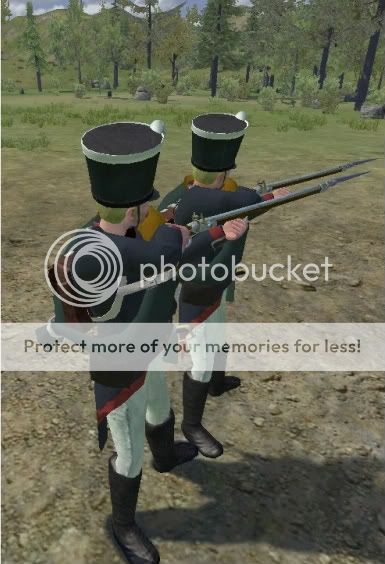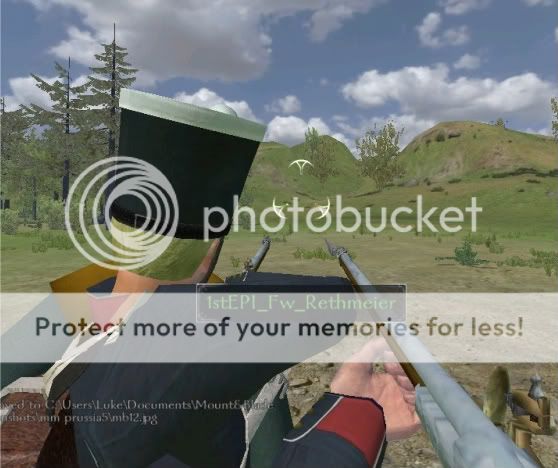6. The School of the BattalionMARCHING STEPS OF THE BATTALION
***
Forward, Common time, MARCH
This type of marching is the most simple, and the default moving pace. The common time is a brisk walking pace; if any order of speed is not given during the marching command, common time is to be assumed.
Double time, MARCH
At this command, the unit should unanimously switch from the common time to the double time. This type of marching is at a faster, but manageable way of moving in a column. This type of marching is ideally not ordered from a standing, halted position.
FORMATION OF THE COMPANY LINE
***
 Figure 6.1 | Guides, POST On this command, the platoon leader of each platoon takes his spot in the company or battalion line, from right to left, according to the number of his platoon. Room for 6-9 files to form, depending on the size of the platoon/Company, is to be left between each guide
,FALL-IN At this order, every soldier falls in, building each file in two ranks from the right to left, to the left of their platoon leader. Two Corporals shall be placed on either side of the platoon for purposes of guiding the privates while in line with minor details. The covering and file-closing sergeants take up their respective positions once the ranks have been formed. Any reserve officers attached to the platoons (this generally being a Second Lieutenant) stand to the right of the 1st file-closing sergeant, and behind the covering sergeant. See Figure 6.1 |
FORMATION OF THE BATTALION LINE
***
Once the Companies are formed and ready, the Battalion Commander will sound for the Companies to form together in one single "Line of Battle", with the order:
Companies, FORM BATTALION
Once this order is given, two of the three companies, (excluding the Color Company or Second Company prescribed before the battle) shall find the Color Company as their guides and dress onto their Line, forming the Battalion Line.

Figure 6.2
Section 6a: Movements in a Line of BattleADVANCEMENT IN LINE OF BATTLE
***
Battalion, Forward
This is the preparatory command. At this point, the Color Guard, (composed of three men, two flanking a Standard Bearer) shall take six steps forwards in front of the Battalion line and hold fast.
MARCH
At this, the entire formation shall step off simultaneously with the advanced Color Guard keeping it's six pace distance. Each file and rank dressing each other to keep close formation, but also keeping a gap in between the Second and Third Company for the Color Guard to post back in to. (This is the only Forward Marching order where the Color Guard will advance first.)

Figure 6.3
ADVANCEMENT IN LINE OF BATTLE BY THE RIGHT GUIDE
***
Battalion, Forward. Guide right.
Upon command, the right-most Company Commander, on the right side of the Battalion shall take his place; if not already posted, in the right-most front rank file.
MARCH.
At the word MARCH, the right-most file steps off, followed by each successive file, and the Battalion advances forward with each file dressing off of the one to it's right. The Captain in the front rank of the right-most file of the First Company is charged with the direction of the march. (Only used sparingly.)

Figure 6.4
ADVANCEMENT IN LINE OF BATTLE BY THE LEFT GUIDE
***
Guide Left, Forward
Upon command, the left-most Company Commander, on the left side of the Battalion shall order a Sergeant to the left-most front rank file; if not already posted, in the right-most front rank file.
MARCH
At the word MARCH, the left-most file steps off, followed by each successive file, and the Battalion advances forward with each file dressing off of the one to it's left. The Sergeant in the front rank of the left-most file of the Third Company is charged with the direction of the march. (Only used sparingly.)

Figure 6.5
TO BRING THE LINE TO A HALT
***
Battalion, HALT
On this order, the Battalion comes to a halt , and each Company comes on to line dressing off of the Second Company. Every file and rank should already be dressed as it comes on to line to avoid the need to have the entire Battalion to dress.
Guides, Post.
At this time, the Color Guard that is still advanced shall take it's place back into the formation.

Figure 6.6
TO RETIRE IN LINE OF BATTLE
***
Battalion, About, FACE.
At the command, FACE, the entire formation shall turn to the right, 180 degrees and march off in the new prescribed direction.
TO MARCH BY THE RIGHT OR LEFT OBLIQUE IN LINE OF BATTLE
***
Right (or left) Oblique, MARCH
The Battalion advances in the same manner as the forward march, but strafes right or left while marching forward. In Mount&Blade Napoleonic Wars, this is achieved by holding down both W, and A (if by the left oblique) or D (if by the right oblique). When marching by the left oblique, the guide must be left. When marching by the right oblique, it must be right.
Forward, MARCH
To correct the oblique march from the previous order's direction the Commander shall order a forward march.

Figure 6.7
WHEELING A HALTED LINE OF BATTLE
***
Battalion, Right (or left) Wheel
At this order, the right or left guide of the Battalion faces the direction of the wheel and blocks up with his weapon to mark the angle of 90 degrees.
MARCH
The files move up onto line and realign themselves. If the guide and wheel is right, the files step off from right to left, and dress right. If the guide is left, the files step off from left to right, and dress left. The guide should match the direction of the wheel, and be called upon a left wheel.

Figure 6.8
WHEELING A MOVING LINE OF BATTLE
***
Battalion, right (or left) wheel, MARCH
The Battalion, while marching forward, can conduct a left or right wheel on the move. The guide signals the wheel by the orders, turns to the specified direction, with each successive file following. During this exercise, the Color Guard shall immediately fall back into place inside the line. Both right and left wheels are conducted with the new guide (right or left) prescribed by the order. When wheeling, care should be taken by the inside files to slow down and react with sufficient promptness so as to avoid collision, and the guide should avoid wheeling quickly and at sharp angles. A small stop shall be made to make sure that the line is in order with the Color Guard moving forward six paces once more, and the command of "Forward, March." being stated to continue.
[Reference Figure 6.8]
Section 6b: Movements in a Column of FilesLINE OF BATTLE INTO A COLUMN OF FILES
***
Starting from the Line of Battle

Figure 6.9
Battalion, Right (or left), FACE
.
Forward, MARCH
The column steps off, to the best of his ability, maintain his position in line and end in the same rank and file from which he started. The forward-most man in the second rank should take care never to step up beside an Officer or Sergeant. Should this happen, he should fall out and rejoin the end of his (or her) Company.

Figure 6.9a
HALT.
The column halts. In order to retain proper spacing, each pair should stop just short of the pair in front of it, and those in the rear (now right) rank should take care to align themselves shoulder to shoulder with their partner to the left.
TO MARCH BY FILES LEFT OR RIGHT IN COLUMN OF FILES
***

Figure 6.10
By File Left (or right), MARCH
Indicates a sharp (90 degree) right or left turn while marching. The inside rank should slow down, and take care not to collide with or out-run the outer rank or space out the column.
FLANKING INTO LINE OF BATTLE FROM A COLUMN OF FILES
***
Battalion, By the Right (or left) Flank,
This is to be done when simply right-facing a column of files into line would cause the line to be inverted, or to fix such an inversion.
The steps forward, faces to the right, and marches forward past the Covering Sergeant, who quickly follows him. The Files stand fast waiting for the order to march.
MARCH
The files march forward, face right, and step up into line, rebuilding the line from right to left. The guide is right, and every man in the left-most rank should find himself behind the man previously to his right. The File-Closers stay their ground, and wait until the platoon is formed to retake their positions.

Figure 6.11
COUNTER MARCHING A COLUMN OF FILES
***
Countermarch, By File Left (or right), MARCH
This command indicates a sharp 180 degree turn to the right or left in a column of files only. As the column comes up to the turn of direction, the men on the inside should briefly slow down to avoid staggering the ranks.
[This may also be achieved with two timed "By File Right (or Left)" commands; at the Commander's discretion.]

Figure 6.12
TO DEPLOY BY FILES FORWARD INTO LINE
***
By Battalion into Line,
This is to be done when the Battalion, marching by the flank in a column of files, need quickly to be brought forward into a line of battle. At this command, the Battalion commander or Company commander will stand fast at the head of the column, in front of the left-most rank, and raising his sword to indicate the line on which the files will form, give the command:
MARCH
Each file, one after the next, maintaining their facing forward, march up and on-to line, rebuilding each file from the right to the left of the Officer.

Figure 6.13
FIRING WITH THE BATTALION
***
Since the Battalion needs it's flag to hold itself together with dressing and keeping general order of whom is whom, great care must be taken for it's Color Guard within the Second Company. The Color Guard will post itself in the Rear Rank of the line, so that it is out of relative harm. The Battalion's officers for which orders are given to from the Commander to the men are also very important. At any order of firing commands the Commanding Company Officer must post themselves in the rear of the line in the approximate middle of their line, in which the Covering Sergeant or Junior Officer shall take his place. Once firing is done, or a movement order is given; all Officers and Color Guards will re-post themselves to their positions once more.
Here is the diagram of the Battalion line:

Figure 6.14
























